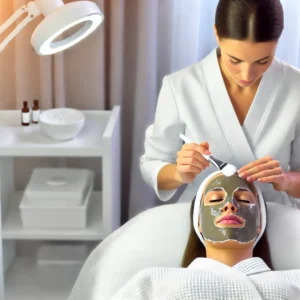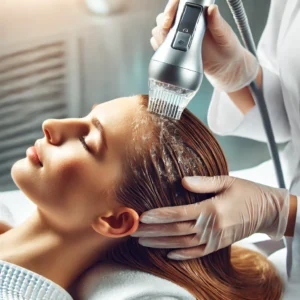Chemical Peeling is a popular skincare treatment designed to improve the appearance of the skin by applying a chemical solution that exfoliates and removes dead skin layers. This treatment helps rejuvenate the skin, address a range of skin concerns, and reveal a smoother, brighter, and more even complexion. It is suitable for various skin types and can be tailored to meet individual skin concerns.
Key Benefits of Chemical Peeling:
- Improves Skin Texture and Tone: Chemical peels help exfoliate the skin, removing dead cells and revealing fresh, new skin underneath. This leads to a smoother texture and a more even skin tone.
- Reduces Fine Lines and Wrinkles: By stimulating collagen production, chemical peels help diminish the appearance of fine lines and wrinkles, providing a more youthful look.
- Treats Hyperpigmentation: Chemical peels can effectively reduce dark spots, sun damage, and hyperpigmentation, creating a brighter and more uniform complexion.
- Clears Acne and Reduces Scarring: Peels help to unclog pores, control excess oil, and reduce inflammation, making them ideal for acne-prone skin. They can also improve the appearance of acne scars over time.
What to Expect During the Treatment:
- Consultation and Skin Analysis: The treatment begins with a consultation to assess your skin type and concerns, determining the appropriate type of chemical peel to use.
- Cleansing and Preparation: The skin is thoroughly cleansed to remove impurities. A preparatory solution may be applied to ensure even penetration of the peel.
- Application of Chemical Solution: The chemical peel solution, which may contain alpha hydroxy acids (AHAs), beta hydroxy acids (BHAs), or trichloroacetic acid (TCA), is applied to the skin. You may experience a tingling or warm sensation as the solution works.
- Neutralization and Moisturizing: After the desired peel time, the solution is neutralized or removed, and a soothing moisturizer is applied to calm the skin and promote healing.
Types of Chemical Peels:
- Superficial Peels: These peels are mild and use gentle acids like AHAs to exfoliate the skin’s surface. They are suitable for improving texture, tone, and mild discoloration.
- Medium Peels: These peels penetrate deeper into the skin and are effective for treating wrinkles, moderate hyperpigmentation, and acne scars.
- Deep Peels: Deep peels use stronger acids, such as TCA, to address more severe skin issues like deep wrinkles, significant sun damage, and pronounced scars. These peels require more downtime and recovery.
Who Should Consider Chemical Peeling?
Chemical Peeling is ideal for individuals looking to improve skin tone, texture, and clarity. It is suitable for those with concerns such as fine lines, acne, sun damage, hyperpigmentation, and dull skin. It is important to consult with a skincare professional to determine the most appropriate peel for your skin type and needs.
Results and Aftercare:
The results of a Chemical Peel include brighter, smoother, and more youthful-looking skin. The skin may appear slightly red or sensitive immediately after the treatment, but these effects typically subside within a few days. It is essential to follow aftercare instructions, including avoiding direct sun exposure, using gentle skincare products, and applying sunscreen diligently to protect the newly exfoliated skin.
Chemical peeling offers a customizable approach to skin rejuvenation, providing both immediate and long-term improvements in skin quality. Whether you are seeking to reduce signs of aging, clear up acne, or brighten your complexion, chemical peels can deliver noticeable results with minimal downtime.
Other Services
- Esthiderm facial with Baby Botox Mesotherapy
- Radio frequency for lifting and infusing collagen
- Esthiderm facial with lifting mask
- Hair Scalp HydraFacial
- Root Strengthening and Hair Growth Treatment
- Hair Loss Treatment
- Meso Therapy
- Meso Botox
- Aqua Gold
- PRP
- Dark Circles
- Pigmentations
- Instant Glow Vitamins
- Open Pores
- Acne Scars
- Intensive Hyaluronic Treatment
- Intensive Vitamin C Treatment
- Black & White heads removal (Manual extraction)
- Hydrafacial (With Microdermabrasion)
- OxyGeneo Treatment
- HYDRAFACIAL WITH DETOX
- HYDRAFACIAL WITH VITAMINS
- DEEP HYDRAFACIAL
- Male laser Hair Removal
- Female hair removal laser
- INVISALIGN
- FLOURIDE APPLICATION
- ZIRCONIA CROWNS, BRIDGES
- NIGHT GUARD
- SIMPLE EXTRACTIO
- SURGICAL EXTRACTION
- ROOT CANAL TREATMENT (RCT)
- VENEERS PER TOOTH
- FILLINGS
- SNAP ON SMILE (UPPER/LOWER)
- Home kit whitening
- Retreatment
- NANO TEETH WHITENING
- SCALING AND POLISHING



